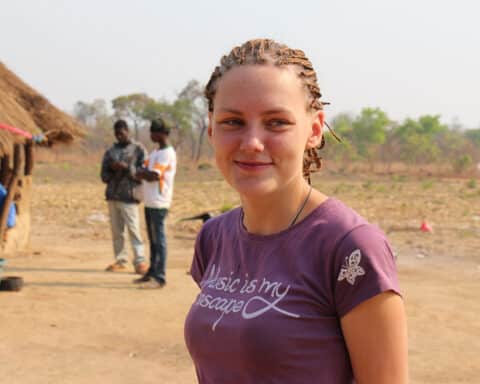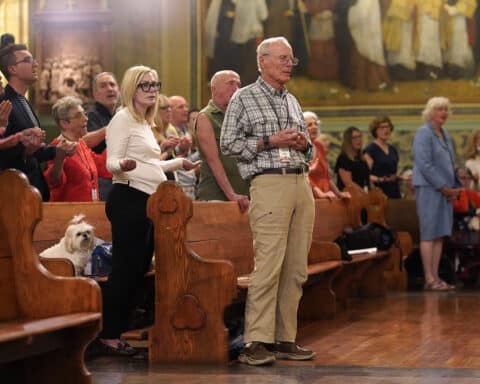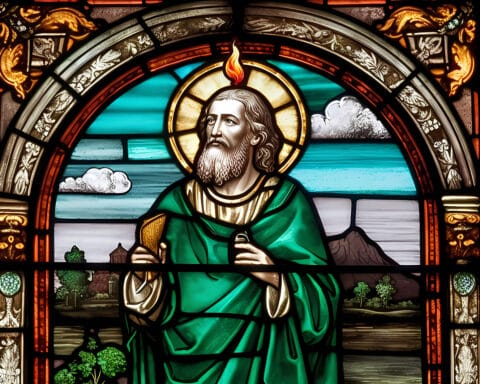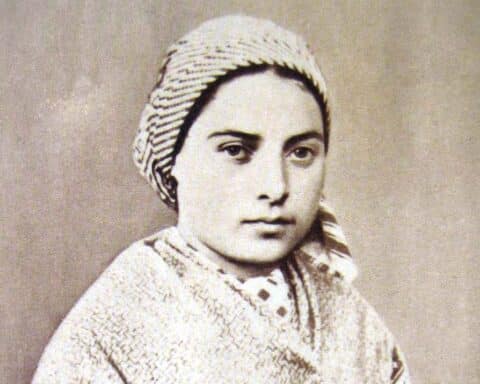Blessed Kateri Tekakwitha (1656-1680)
Saints are not given to moderation — at least not when it comes to showing their love for Christ. And Blessed Kateri Tekakwitha was certainly no exception.
Born in upstate New York, the daughter of a Mohawk chief, Blessed Kateri lost her family to smallpox when she was only four. Later adopted by her uncle, she lived a quiet life, avoiding others and hiding her face, which bore the traces of smallpox, from public view. When Jesuit missionaries came to her camp, however, Kateri did not hesitate to meet them.
Faith came quickly to the Mohawk princess. It did not, however, come cheap. There was a cost.
First, Kateri’s uncle opposed her baptism. Later, after he consented, both her family and her fellow villagers opposed her efforts to practice the faith, mocking her for not working on Sundays and criticizing her decision to remain celibate. Eventually, with the help of her brother-in-law, Kateri escaped her uncle’s house, heading north to modern-day Canada, where a community of Mohawk Christians and Jesuit missionaries lived. There, Kateri made a vow of perpetual virginity and embarked on a life of extreme penance, frequently fasting, praying long hours in a freezing chapel, and even sleeping on a bed of thorns.
Her extreme devotion most likely contributed to her early death at the age of 24. It also, however, earned her the admiration of all who knew her and led to her veneration by Catholic Americans, Native Americans and Canadians for centuries after her death. Finally beatified by John Paul II in 1980, Kateri Tekakwitha bears the distinction of being the first Native American to hold the title “Blessed.”
Blessed Junipero Serra (1713-1784)
The Franciscans of Spain had great plans for Padre Junipero Serra. The order invested immense amounts of time and money in the young priest’s education, sending him to study theology and philosophy at their best schools and honoring him with a chair in theology at the Lullian University in Palma at the early age of 31. He was to be a great scholar and teacher.
Fortunately for the Church in America, however, Padre Serra did not want to be a great scholar and teacher. He wanted to be a missionary. And, after much prayer, Serra got what he wanted. In 1749, his superiors granted his request to sail for the Americas. Eight months later, Serra and his companions arrived on the shores of Mexico.
For the next 19 years, Serra taught and preached at missions throughout Mexico, as well as in Mexico City’s San Fernando College. Then, in 1769, he was commissioned with carrying the Gospel north into California. Despite suffering from asthma and painful ulcers in his legs, Serra accepted the commission and went on to found nine missions in the next 13 years: San Diego, San Carlos at Monterey, San Antonio, San Gabriel, San Louis Obispo, San Francisco, San Juan Capistrano, Santa Clara and San Buenaventura.
By the time of his death in 1784, he had traveled more than 24,000 miles, founding not only the missions that would become California’s first cities, but also introducing the native population to systems of irrigation and agriculture and pressuring the Mexican government to adopt laws protecting the rights of California’s native inhabitants. Considered the father of Catholicism in California, Father Junipero Serra was beatified by Pope John Paul II in 1988.
Blessed Francis Xavier Seelos (1819-1967)
If you want to become a saint, it helps to know one. Case in point: Blessed Francis Xavier Seelos.
The Bavarian-born Seelos came to America as a seminarian in 1843 to minister to German-speaking Catholics. After completing his theological studies in Baltimore and being ordained a priest for the Congregation of the Most Holy Redeemer (the Redemptorists), Father Seelos was assigned to serve under the future St. John Neumann in Pittsburgh. As a parish priest at St. Philomena’s, Father Seelos spent hours in the confessional, his believed ability to read souls drew penitents from across the region.
Together, Neumann and Seelos preached missions throughout the city. Of their relationship, Seelos once said: “He has introduced me to the active life … and guided me as a spiritual director and confessor.”
After leaving Pittsburgh, Seelos went on to serve in parishes in Maryland, Michigan and Louisiana. During the Civil War, he also served as an itinerant preacher, taking the sacraments to Catholics in Connecticut, Illinois, Michigan, Missouri, New Jersey, New York, Ohio, Pennsylvania, Rhode Island and Wisconsin. Although Pope Pius IX offered him the See of Pittsburgh in 1860, Father Seelos declined, preferring the life of parish priest to that of bishop.
And it was as a parish priest that Father Seelos died. In New Orleans in 1867, while ministering to his parishioners who suffered from yellow fever, he contracted the illness, dying at the age of 49. Like Neumann, he is considered a model for all parish priests and was declared “Blessed” by Pope John Paul II in 2000.
Blessed Carlos Manuel Rodriguez (1918-1963)
Not all of the American “Blesseds” wore religious garb. One wore the habit of a layman: Carlos Manuel Rodriguez, popularly known as “Charlie.”
By day, he was an unassuming office clerk. By night (and by weekend), he was one of the foremost catechists and evangelists in Puerto Rico: publishing a magazine, organizing campus ministry programs at the University of Puerto Rico and the Catholic University Center, and teaching the catechism to schoolchildren.
Ill health prevented him from ever marrying or entering religious life. But rather than seeing his health as an obstacle, he chose to see it as an opportunity to serve the Church more energetically. He dedicated nearly all of his salary to his catechetical endeavors and became an ardent supporter of liturgical renewal.
Cancer took Rodriguez’s life in 1963. It wasn’t long, however, before a campaign for his canonization was launched. In 1992, his case for sainthood was opened. In 1997, he was declared “Venerable” by Pope John Paul II, and he was beatified in 1999.
Blessed Marianne Cope (1838-1918)
Born in Germany, but raised in America, Mother Marianne was no stranger to the sick. Although she entered the Franciscan order with the intention of teaching, her administrative skills soon came to the notice of her superiors. First she was put in charge of schools and, later, one of the two hospitals the Franciscans founded in central New York.
In 1883, at the request of the Hawaiian government, she took six women from her community to the islands to establish a system of hospital nursing for the poor. After their arrival, they founded the island of Maui’s first hospital and took over the administration of the main hospital on Oahu, where they cared for all the Hawaiian lepers who had not been shipped to Molokai.
Five years later, when the Hawaiian government began reinforcing a strict deportation policy for all victims of leprosy, Mother Marianne and her sisters went with their patients. On Molokai, at Father Damien’s request, they took over the boys and girls homes, and oversaw the care of the island’s patients.
Mother Marianne remained on the island until her death at age 80 in 1918. Neither she, nor any of the sisters who served with or after her, ever contracted leprosy. In May 2005, she was among the first to be declared “Blessed” by Pope Benedict XVI.
Pray for Us
Along with St. Damien of Molokai, Pope Benedict XVI is scheduled to enter four additional saints into the canon Oct. 11.
St. Marie de la Croix (Jeanne) Jugan: (1792-1879): St. Marie de la Croix, born Jeanne Jugan, lived as a single laywoman in France until, at the age of 50, she founded the Little Sisters of the Poor. Although she was quickly forced out of leadership in the community and persecuted for the remainder of her life, Jeanne lived long enough to see the order expand exponentially, numbering 2,400 sisters in 10 countries by the time of her death. Today, the Little Sisters of the Poor continue their original mission of caring for the elderly in 32 countries around the world.
St. Zygmunt Szczesny Felinski (1822-1895): As a newly ordained priest, the Polish St. Zygmunt Szczesny Felinski founded the Congregation of Franciscan Sisters of the Family of Mary. He later served as archbishop of Warsaw for 16 months before his opposition to the Russian occupiers of his city earned him a trip to Siberia. There, he spent 20 years in exile, caring for the poor and his fellow prisoners. He spent another 12 years in semi-exile in the Krak”w region (which then belonged to Austria), where he built a church and a convent for the religious order he founded decades earlier.
St. Francisco Coll y Guitart (1812-1875): After entering the minor seminary in his home diocese at the age of 12, St. Francisco Coll y Guitart went on to join the Spanish Dominicans at the age of 18. After his ordination to the priesthood in 1836, he became one of his country’s most popular priests, preaching missions throughout northeastern Spain, and founding the Congregation of Dominican Sisters of the Annunciation of the Blessed Virgin Mary.
St. Rafael Arnaiz Baron (1911-1938): Between his battle with diabetes and the Spanish Civil War, St. Rafael Arnaiz Baron was forced to leave his Trappist monastery three times in the four years he was a member of the community. In spite of those obstacles, he remained faithful to his vocation and eventually died as an oblate at the monastery, leaving behind a rich legacy of mystical writings and is considered one of the great mystics of the 20th century.
Steps to sainthood
The Catholic Church doesn’t make saints: That’s God’s job. Rather, the Church simply recognizes what God has already done. That recognition, however, is a lengthy process that often can take centuries.
Step 1:
The process begins when the local bishop opens a person’s cause for sainthood. In other words, he determines that enough evidence of an individual’s holiness exists to suggest that his or her life merits closer investigation. Typically five years must elapse between a person’s death and the opening of a cause. This requirement can, however, be waived. When a person’s cause is opened, he or she receives the title “Servant of God.”
Step 2:
After the life is investigated and witnesses have offered testimony about the individual’s life and faith, the information gathered is sent to Rome. There the theologians and cardinals who make up the Congregation for Saints’ Causes examine the gathered testimony. If they agree that the person is a model of Christian virtue, the person is awarded the title “Venerable.”
Step 3:
In order for an individual to be beatified and bear the title “Blessed,” there must be clear evidence of a posthumous miracle. Martyrs, however, can be beatified without proof of a miracle. Once beatified, the individual can be venerated by particular groups or in particular regions.
Step 4:
Before a person can be canonized, there needs to be proof of another miracle, performed after beatification. This is the final step, and once the miracle has been approved, a person can officially be recognized as a saint.
The American Canon
With his Oct. 11 canonization, St. Damien of Molokai officially joins the small, but growing canon of American saints. The eight other American saints are:
St. Elizabeth Ann Seton (1774-1821):American-born wife, mother and founder of the American Sisters of Charity. Canonized Sept. 14, 1974.
Feast day: Jan. 4.
St. John Neumann (1811-1860):German-born missionary, Redemptorist priest and fourth bishop of Philadelphia. Canonized June 19, 1977.
Feast day: Jan. 5
St. Rose Duchesne (1769-1852):French-born missionary and religious sister. Canonized July 3, 1988.
Feast day: Nov. 18
St. Isaac Jogues (1607-1646):French-born missionary, Jesuit priest and martyr. Canonized June 29, 1930.
Feast day: Oct. 19
St. Rene Goupil (1607-1642):French-born missionary, Jesuit brother, companion to St. Isaac Jogues and martyr. Canonized June 29, 1930.
Feast day: Oct. 19
St. Katharine Drexel (1858-1955):American-born heiress, religious sister, founder of the Sisters of the Blessed Sacrament and founder of 63 schools, including Xavier University in New Orleans. Canonized Oct. 1, 2000.
Feast day: March 3
St. Frances Cabrini (1850-1917):Italian-born missionary and founder of the Missionary Sisters of the Sacred Heart of Jesus. Canonized July 7, 1946.
Feast day: Nov. 13
St. Theodore Guerin (1798-1856):French-born missionary and religious sister. Canonized Oct. 15, 2006.
Feast day: Oct. 3




